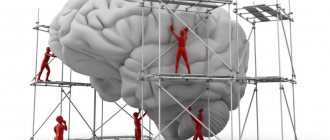The definition of “gestalt” in psychology comes from the German words “image”, “form”, “structure”. It means the integrity of perception or the balance of forces influencing the elements of the surrounding world. Gestalt psychology is based on the principle: unfinished business and unhappened events prevent a person from enjoying life.
Gestalt psychology and gestalt therapy
The concept of Gestalt psychology appeared around 1912, when Max Wertheimer described the phenomenon of the irreducibility of the perception of the whole to a collection of individual elements.
What is Gestalt? This term refers to the concept of a single whole, which is something different from the sum of its individual parts. What the two terms have in common is only the word gestalt. The founder of therapy, Perls, had a superficial understanding of Gestalt psychology, having mastered only part of the fundamental works devoted to this issue. He used some ideas, but nothing more.
Gestalt is a direction in psychology, and therapy contains only a small part of its elements. It is a mixture of psychodrama, analytics and bioenergetics.
Gestalt psychology - what is it in simple words? This is a scientific direction aimed at studying the characteristics of human perception. Several interesting features of the psyche were found experimentally, such as the laws of correlation and grouping of objects.
The basic principle of Gestalt psychology: the whole is not just the sum of its parts, but something more significant. A person perceives his surroundings holistically, that is, he does not see a collection of individual lines and points (a tree, and not a set of leaves, branches and a trunk).
Gestalt psychology
This direction of psychology received its name from the German word “gestalt”, which means “form”, “structure”, “integral configuration”, i.e. an organized whole whose properties cannot be derived from the properties of its parts.
The development of Gestalt psychology is associated with the revolution in physics that occurred at the turn of the 19th and 20th centuries. It arose as an alternative to behaviorism and associative psychology, which were popular at that time. The German psychologist Max Wertheimer is considered its founder, but such famous psychologists as Kurt Koffka, Wolfgang Keller, Kurt Lewin also participated in its development.
Gestalt psychology denied the principles of division of consciousness. Its representatives believed that perception is not a set of feelings, and the features of the image are not recreated using the signs of its components. Instead of searching for individual elements of consciousness, Gestalt psychologists focused on its integrity. They viewed human consciousness as a whole, embraced by dynamics. Consciousness connects all components into a single whole, forming a gestalt.
Gestalt are integral formations of consciousness, irreducible to the sum of their parts. Imagine that you come to a gallery to admire your favorite painting by Vincent Van Gogh. Looking at it, you do not see and evaluate every stroke of the artist. You see the picture as a whole, the overall combination of colors, shapes, composition. Those. there is a holistic perception of the picture, which is not reduced to the sum of its constituent elements. This holistic perception came to be called “gestalt.”
Formed gestalts are always holistic. They are complete structures. The main quality of Gestalt psychology is the desire for completion, which manifests itself in the “Zeigarnik effect” (incomplete processes are remembered better).
Gestalt psychology has found its continuation in the modern direction of psychotherapy - Gestalt therapy, the founder of which is psychologist Friedrich Perls.
Gestalt therapy assumes that a person’s entire life consists of an infinite number of gestalts. Gestalt therapists help patients see and understand how unfinished gestalts affect their lives in the present. During this therapy, a person learns to close and complete these gestalts, because incomplete gestalts can cause some problems.
Defense Mechanisms
The main Gestalt approach in psychology is understanding and respecting human defense mechanisms necessary for comfortable interaction with the outside world. They are required by the individual to interrupt traumatic contact and maintain his integrity.
Even at an early age, a person unconsciously creates defense mechanisms, considered in Gestalt psychology. They allow you to get out of a traumatic situation and interrupt contact with the environment. On the other hand, their appearance leads to the fact that the situation does not have its end, since the discomfort is poorly recognized and the traumatic events are repeated again.
What are defense mechanisms in gelstatt psychology? These are neurotic processes and behavioral characteristics that are unconsciously used by a person to interrupt painful contact. Experiences and painful feelings are a signal of an urgent need. However, the peculiarities of the human psyche are such that he often unconsciously resorts to self-manipulation and self-regulation.
Self-manipulation - what is it in Gestalt psychology? A method to stop identifying feelings and satisfying a specific need. Often a person is not able to navigate his experiences and concludes that his needs should be satisfied by others, or, on the contrary, he directs negative feelings towards himself and not into the external environment. This is what the defense mechanism looks like: avoidance occurs, interruption of contact with the environment.
The main defense mechanisms in Gestalt psychology are:
- introjection is a state in which a person, without internal evaluation, allows into himself any attitudes or moral principles of other people, blindly accepting them on faith;
- confluence (merging with someone) manifests itself in the fact that it is difficult for a person to distinguish himself from others or to highlight his main experience. In this case, the pronoun “we” will constantly appear in the subject’s speech;
- egotism is an exaggeration of the ego, when the subject closes himself in and cannot allow himself to be completely dissolved in what is happening (man in a case);
- projection is when a person attributes to other objects something characteristic of his inner world;
- retroflection is when a person addresses to himself what was intended for the environment (reverse projection).
Gestalt therapy is carried out over a long period of time and carefully, under the guidance of an experienced specialist. A person with psychological problems, even in childhood, gets used to existing within a certain emotional framework (a tunnel of defense mechanisms) and a forced withdrawal beyond this limitation can be complicated by psychosomatic diseases or even decompensations. It will be better if intense experiences and “passions” enter the client’s life gradually.
A Gestalt psychologist will help a person gain awareness; for this purpose, the therapy arsenal includes special techniques and techniques that allow one to gradually adapt and get out of a difficult state and achieve full contact with the environment.
Kurt Koffka and studies of perception in children
Kurt Koffka is a German and American psychologist, together with Wertheimer and Keller, considered one of the founders of Gestalt psychology.
In his article “Perception: An Introduction to Gestalt Theory,” he outlined the basics of Gestalt psychology, as well as the results of many studies. In 1921, Koffka published the book “Fundamentals of Mental Development,” dedicated to the formation of child psychology
Koffka conducted research on the development of perception in children, which showed that the child has a set of inaccurate and not very adequate images of the external world. Over the course of life, these images are separated and become more accurate.
For example, newborns have a vague image of a person, the gestalt of which includes a voice, a face, hair, and characteristic movements. Therefore, a small child of one or two months may not even recognize a close person if he changes his hairstyle or changes his usual clothes to completely unfamiliar ones. But by the end of the first half of the year, this vague image is divided, turning into a series of clear images: a face, in which the eyes, mouth, hair stand out as separate gestalts, and images of the voice and body appear.
Koffka also studied children's perception of color.
At first, children perceive their surroundings only as colored or uncolored, while the uncolored is perceived as a background, and the colored as a figure. Gradually, colored is divided into warm and cold, and in the environment children already distinguish several “figure-ground” sets (for example, uncolored-colored warm, uncolored-colored cold, etc.). Thus, the formerly single gestalt turns into several, more accurately reflecting the color. These images also become fragmented over time: yellow and red colors stand out in warm ones, and green and blue in cold ones. This process occurs over a long period of time until, finally, the child begins to correctly perceive all colors.
Koffka came to the conclusion that the combination of figure and background against which a given object is demonstrated plays an important role in the development of perception. He formulated one of the laws of perception, which was called “transduction” . This law proved that children do not perceive colors themselves, but their relationships.
Gestalt therapy: techniques, what Gestalt therapy teaches
The leading methods of therapy are role-playing games. These practices help the client find a solution to the problem and find a way out of a deadlock. F. Perls has found an effective technique that allows you to free yourself from negativity and find a solution to the problem. It's called "empty chair". The person is asked to imagine that a specific person is sitting on him. It is easier for an imaginary interlocutor to “express” complaints and free himself from psychological burden.
A frequently used technique in Gestalt therapy is dream analysis. It is believed that the technique allows you to determine the individual characteristics of the client, as well as restore in memory any traumatic situations from the past. A person is asked to keep a diary for 2 weeks in which to record dreams. Then you need to choose the brightest one and play it in the presence of a specialist. It is expected that this will help reconnect with episodes of the past that the client previously refused to acknowledge.
A well-known Gestalt method is pillow beating, which releases unspoken anger. The client imagines an object that causes him aggression and beats him, getting rid of pent-up anger.
The following Gestalt technique helps to increase awareness:
The client says out loud a phrase that clearly defines his self, for example:
- I realize that I am in this room and sitting on a chair;
- I realize that I am currently feeling sad.
In this way, the subject separates his internal sensations from subjective assessments and interpretations. This simple and very common technique helps to create an image of how the patient is aware of himself.
Fritz Perls
Fritz Salomon Perls (1893-1970) is considered the founder of the Gestalt therapy method His basic education was psychoanalysis and Perls practiced it for a long time. The beginning of the history of Gestalt therapy can be considered the appearance of the book “Ego, Hunger and Aggression” (1942), which presents a rather radical rethinking of the theory of Sigmund Freud, the founder of psychoanalysis.
Unfinished Gestalt
The founder of Gestalt therapy, F. Perls, identified the main reason for the internal feeling of dissatisfaction with life (in other words, lack of happiness). In his opinion, the factor creating neurosis is not a closed gestalt. To complete it, it is necessary to achieve an indifferent attitude towards it. The more negative the client feels about the situation, the more difficult it is to achieve closure of the gestalt.
What is an incomplete gestalt in psychology? This is an unachieved goal that provokes a repetition of life situations and connects the client with certain people. In other words, this is:
- unfulfilled desires;
- unfinished business and plans;
- an unexpected and painful break in personal relationships.
Any episode from life that periodically emerges in memory and at the same time causes strong negative experiences is an incomplete gestalt.
You should get rid of it for two reasons:
- The situation causes internal tension, anxiety and discomfort. Creates life dissatisfaction and decreased self-esteem.
- It becomes a serious obstacle to achieving other goals. A person feels unsure of his abilities.
Often such people cannot establish contacts with others, exhausting them with constant excursions into the past and complaints about dissatisfaction with life. In this case, conscious actions upon completion of the gestalt will help. Psychologists recommend realizing the most simple and even ridiculous dream, the achievement of which will not take much effort and time. For example, you can learn to cook some exotic dish, dance the waltz or swim breaststroke. It has been noticed that after this the remaining, more important gestalts will begin to close.
Projection and introjection in Gestalt therapy
To increase awareness, psychologists teach clients to work with two main defense mechanisms - projection and introjection:
- Projection is a feature of the psyche when a person tends to attribute to living and inanimate objects properties inherent in his own inner world. Man by nature tends to anticipate events, relying on his negative experience. In the client’s speech this is manifested by an abundance of pronouns “they” and “you”. A person is unable to recognize anger or hostility in himself, complains about others, projecting his emotions onto them: “they don’t like me,” “you don’t value me.”
- The state when a person transfers to others qualities or emotions that he himself possesses or would like to have is called mirror projection. Often this situation does not allow the individual to recognize his valuable traits or qualities, attributing them to strangers, and considering himself unworthy of possession.
- The situation when a person transfers to others properties or emotions that he does not want to recognize in himself is called the projection of catharsis.
- There is also an additional projection when an individual gives others far-fetched properties, attitudes, emotions that somehow justify his own unsightly qualities.
- The mechanism by which a person internalizes other people's ideas or principles without critical evaluation and reflection is called introjection. The speaker conveys such things in a peremptory tone. For example: “elders must be respected,” “being late is rude,” “it is unacceptable to hurt a person.”
As children develop, they learn behavioral patterns, attitudes, ideas about others, beliefs, and ways of interacting with people. They perceive them without understanding responsibility and project them into their lives, receiving feedback. A healthy adult attitude is to see the world clearly, be aware of one's projections, and show responsibility and empathy for others. During therapy, the therapist helps the client gain awareness and take responsibility for life events.
Who can benefit from Gestalt psychology and therapy?
Gestalt therapy has the widest range of application, which is much larger than that of other areas of psychology. Individual, family and group therapy, work with childhood clients, seminars, etc. are possible. This type of therapy is used in private and public medical institutions, as well as personal growth centers.
What is Gestalt psychology and who is it recommended for? This area of psychology is of interest to clients working to expand self-awareness, develop responsibility, and self-improvement.
Gestalt therapy is applicable to working with groups of people of different ages and clients with severe psychological disorders. The method is most effective in treating clients with phobias and depression, violation of internal restrictions, increased anxiety and a tendency toward perfectionism.
The therapy is also successfully used in the elimination of psychosomatic diseases, for example, gastrointestinal dysfunction, migraine headaches, spasms of the back and neck muscles. Gestalt therapists also work with couples to resolve psychological conflicts. Sessions can help with some mental disorders and severe emotional disorders.
Pearls' Gestalt approach as psychotherapy
As already mentioned at the very beginning, there is no systematic description of the method itself, nor its theoretical justification. Perls's method is described in his works "Ego, Hunger and Aggression" and "Gestalt Therapy". This is a set of practical techniques that allow the client to develop awareness of himself as an organism and as a person, and also to identify violations of the normal functioning of this system, which lead to psychological problems and blocking of development.
Comment via Facebook
Comment








